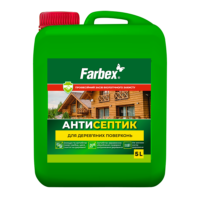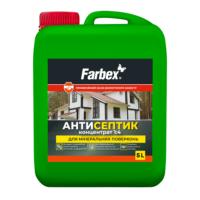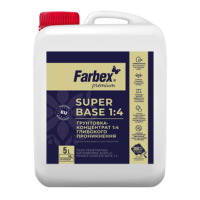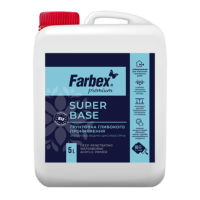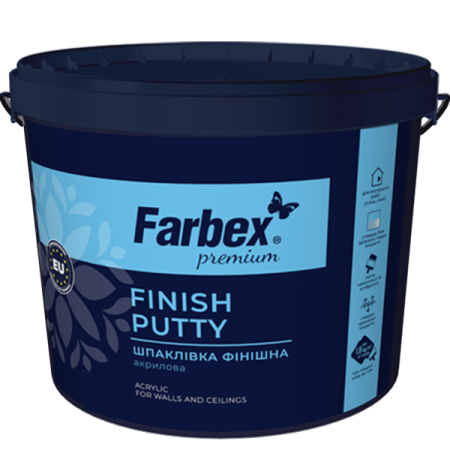
Specification
It creates a perfectly white and smooth surface. The coating thickness is 2 mm. It is easy to apply and grind. It is perfect to apply manually and with the help of special machinery. The putty has good adhesion to the base surface and vapor-permeable effect. It dries quickly. It is intended for interior works.
Sphere of application
It is ready for use snow-white finishing structure, which is intended for finishing of walls and ceilings before coating with paints or application of wall-papers and it is also used for making a connection between gypsum boards. It is applied on the plaster, putty, gypsum boards, lime-mortar and gypsum surfaces, fiberglass-based wallpaper, wood chipboards, MDF, OSB-boards, etc.
Tinting
It can be tinted manually with Pigment Concentrate Farbex Color, other waterborne coloring pastes or with a coloring machine acc. to NCS color range and others.
Content
Technical data
| Consumption standard of 1 layer | 1,8 kg/м2 if a coat thickness is 1 mm |
| Thinner | WaterIt is allowed to dilute it max. 5% of the total weight. |
| Application | It is applied with a stainless applicator or with a special spraying gun. |
| Drying period (23 °С, 50% RH) | 3 hours, if coat thickness is of 1 mm |
| Solids content (DSTU ISO 3251) |
72±2 % |
| Density (DSTU ISO 2811-1) | ≈ 1,78 g/сm3 |
| Particle size | max. 100 microns, (fine-grained, S1, SSU EN 1062-1) |
| Resistance to washing | , (fine-grained, S1, SSU EN 1062-1) |
| Gloss (DSTU ISO 2813) | - |
| Water permeability (DSTU EN 1062-3) | |
| Vapor permeability (EN ISO 7783-2) | |
| Marking acc. to the DSTU EN 16566 | G3|S1|V1|W1|A0|C0|RD |
| Non-volatile matter by volume (DSTU ISO 3233) |
50±2 % |
| VOC content (ISO 11890) | ≈ 25 g/l |
| Warranty period | 18 months from the date of manufacturing (at the temperature from +5 °С till +35 °С) |
| Packaging | 1,5 kg, 5 kg, 17 kg |
Gloss
Color
Application instruction
-
1. Surface preparation
The surface shall be dry, thoroughly cleaned from loose coatings, dust, dirt, oil, grease and others.
It is necessary to treat the surface with Antiseptic for wooden or mineral surfaces TM "Farbex" for protection against fungi.
Highly absorbing, fragile and porous surfaces shall be treated with Deep-penetrating Primer TM "Farbex".
2. Priming
-
3. Puttying
Stir the putty before use thoroughly. The primer is ready to use. If necessary, dilute it with water. The temperature of the air and the surface under application shall be from +10 °С to +30 °С and relative air humidity no more than 80%. Apply putty with a stainless steel spatula or special spray. The big size recession shall be puttied in several layers.
Before painting, the plastered surfaces should be sanded and undercoated.
For wooden surfaces, use Wood-protective primer TM Maxima on an alkyd or acrylic base, depending on the type of finishing covering.
According to the recommendations for use, Deep penetrating water dispersion acrylic primer "Super Base" TM Farbex shall be used on mineral surfaces.
4. Tool cleaning
Clean tools with water after application. Do not let them dry.
Use with this product
Tips

Шпаклівка для стін. Як обрати та підготувати стіни до шпаклювання
Перед нанесенням будь-яких оздоблювальних матеріалів необхідно правильно підготувати поверхню. Якщо для укладання плитки достатньо штукатурки, то перед фарбуванням чи наклеюванням шпалер стіни треба зробити ідеально рівними та гладкими. Для шпаклювання стін використовують спеціальні суміші – шпаклівки. Без досвіду легко заплутатися …
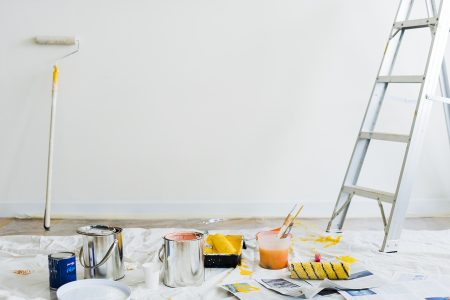
Підготовка стін перед фарбуванням
Фарбування стін – простий і ефективний спосіб оновити дизайн інтер’єру або зробити повне перевтілення кімнати. Розглянемо ряд кроків, які допоможуть якісно підготувати стіни перед фарбуванням: Перший етап – облаштування приміщення. На цьому етапі завдання – максимально звільнити кімнату від меблів …
Flow calculator
Consumption standard of 1 layer
When calculating the area to be painted, you need to subtract the area that will not be painted. (windows, doors, etc.)
Paint consumption may vary depending on dilution and uniformity of application of the paint.
